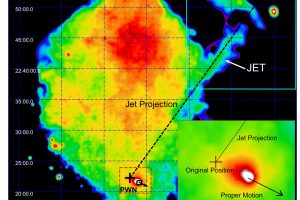A peculiar supernova remnant. Published on A&A the study: “Discovery of a jet-like structure with overionized plasma in the SNR IC 443” of E. Greco (OAPA/UNIPA)

Supernova remnants, i.e. the remnant of supernovae explosions, are among the most interesting astronomical objects. In fact, they are not only produced by one of the most violent phenomenon occurring in the Universe (the explosion of a supernova from the collapse of the core of a massive star, i.e. a “core-collapse supernova”, which emits the same energy of 1033 atomic bombs such as the one of Hiroshima exploding simultaneously). Supernova remnants are also characterized by important phenomena, such as the acceleration of cosmic rays, and they can unveil information on the progenitor star, the collapse of its core and the supernova explosion, still not fully understood.
Supernova remnants have different morphologies, some of which are difficult to interpret, such as the “mixed-morphology supernovae remnants”. These remnants are characterized by a peaked thermal X-ray emission in their core surrounded by a radio emitting shell. In some cases, these remnants are also observed to be over-ionized, i.e. with a degree of ionization larger than the one expected from the temperature of the gas. Two remnants of this type have been the subject of studies led by astronomers of the Astronomical Observatory of Palermo: W49b (Miceli et al. 2010) and IC 443 (Troja et al. 2008).
The supernova remnant IC 443 is also the subject of the study “Discovery of a jet-like structure with overionized plasma in the SNR IC 443“, which is part of the thesis of E. Greco, Ph.D. student of the University of Palermo and the Astronomical Observatory of Palermo. The authors of this study have analyzed new X-rays images of IC 443 obtained from the satellite XMM-Newton of the European Space Agency, obtaining interesting results. In fact, they have identified a jet-like structure in the remnant which has been produced by the explosion of the supernova. The gas in the jet is over-ionized, likely because of the interaction of the jet with the surrounding circumstellar material. This is the third known supernova remnants with a jet and the first known case of over-ionized jet. Besides, the direction of the jet points toward the position that the neutron star CXOU J061705.3+222127, lying inside IC 443, had at the time of the explosion, dated 4000 years ago, which is a striking evidence that the neutron star is the compact object formed from the collapse of the progenitor star, which is been debated to date because of the position and motion in the sky of the neutron star. The study has been published in Astronomy & Astrophysics with the collaboration of the astronomers M. Miceli (INAF-OAPA/UNIPA), O. Salvatore (INAF-OAPA), G. Peres (INAF-OAPA/UNIPA), F. Bocchino (INAF-OAPA) and E. Troja (NASA Goddard Space Flight Center).
The figure (link) shows an X-ray image of IC 443 with marked the jet and the position of the neutron star.
